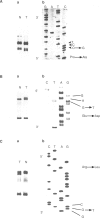Abstract
Inactivation of the tumour-suppressor gene p53 has been described as one of the most common molecular changes found in lung tumours. Our purpose was to study the prognostic value of p53 alterations and to determine whether some specific mutation type in the p53 gene could be associated with poor clinical evolution in non-small-cell lung cancer (NSCLC) patients. To this end, we studied 81 resected primary NSCLCs in order to detect p53 alterations. p53 protein accumulation was analysed using immunohistochemistry methods; p53 gene mutations in exons 5-9 were studied using polymerase chain reaction-single-strand conformation polymorphism and sequencing techniques. p53 protein was immunodetected in 46.9% of lung carcinomas and 44.7% of p53-immunopositive tumours showed p53 mutations. Survival analysis was performed on 62 patients. No survival differences were found for patients with or without p53 immunopositivity. A shorter survival was found in patients with underlying p53 gene mutations, mainly in patients with squamous cell lung tumours; the worst prognosis was found when mutations were located in exon 5 (P = 0.007). In conclusion, the location of p53 mutations might be considered as a prognostic indicator for the evaluation of poor clinical evolution in NSCLC patients.
Full text
PDF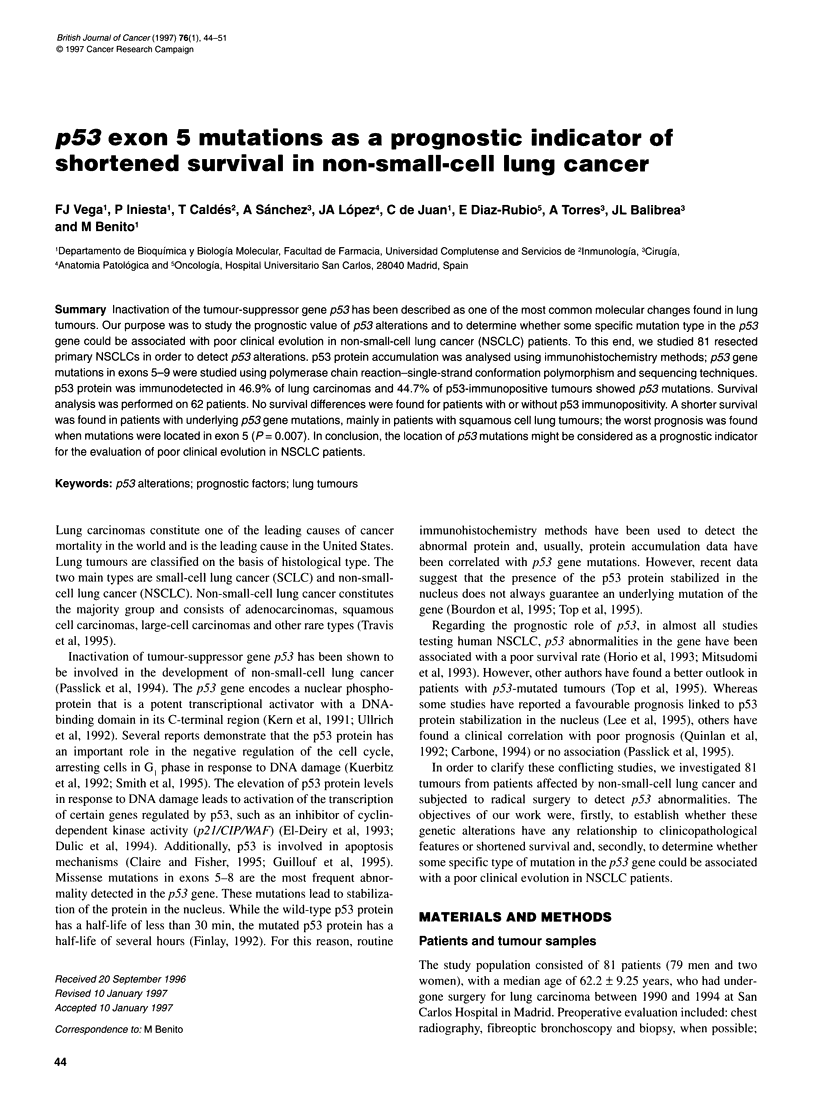
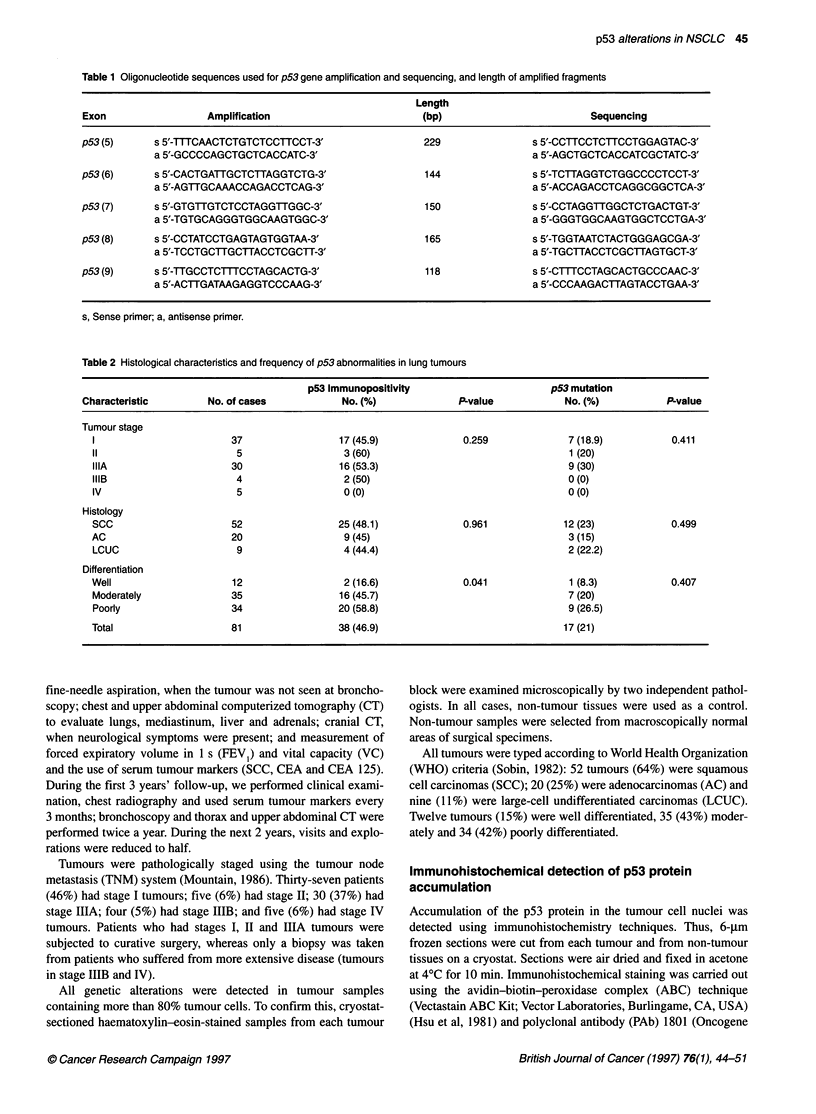

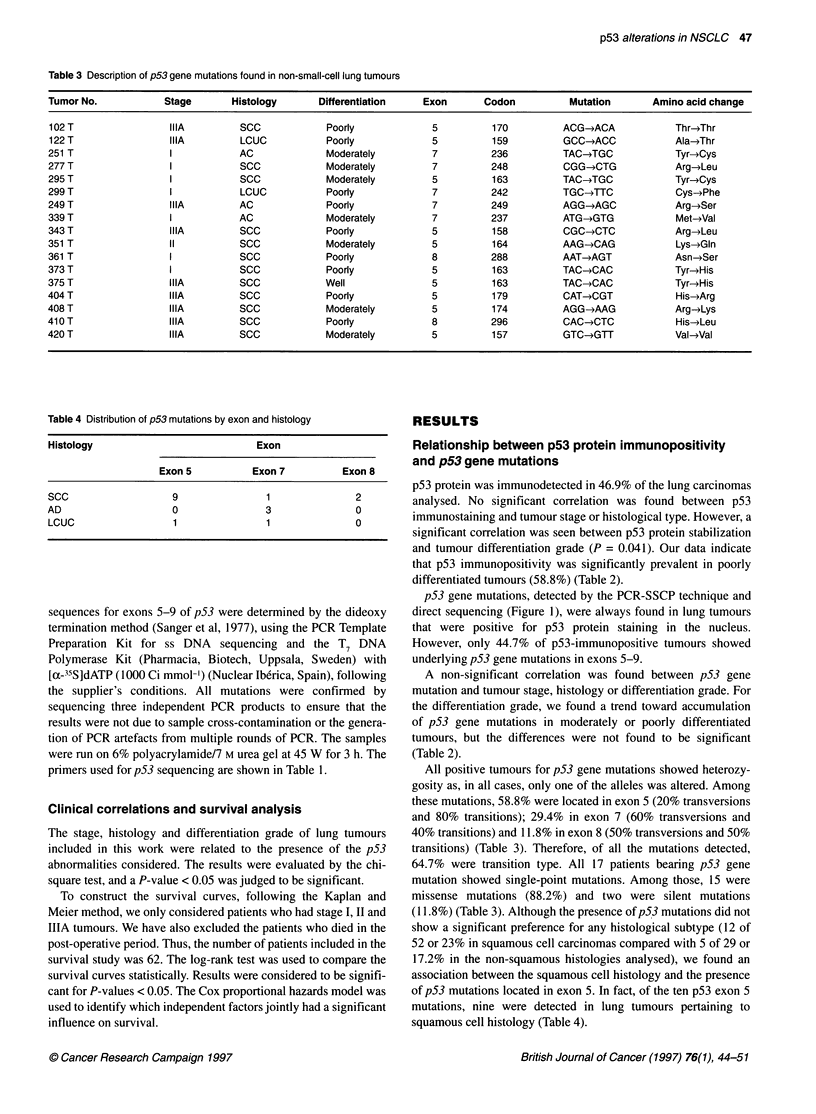
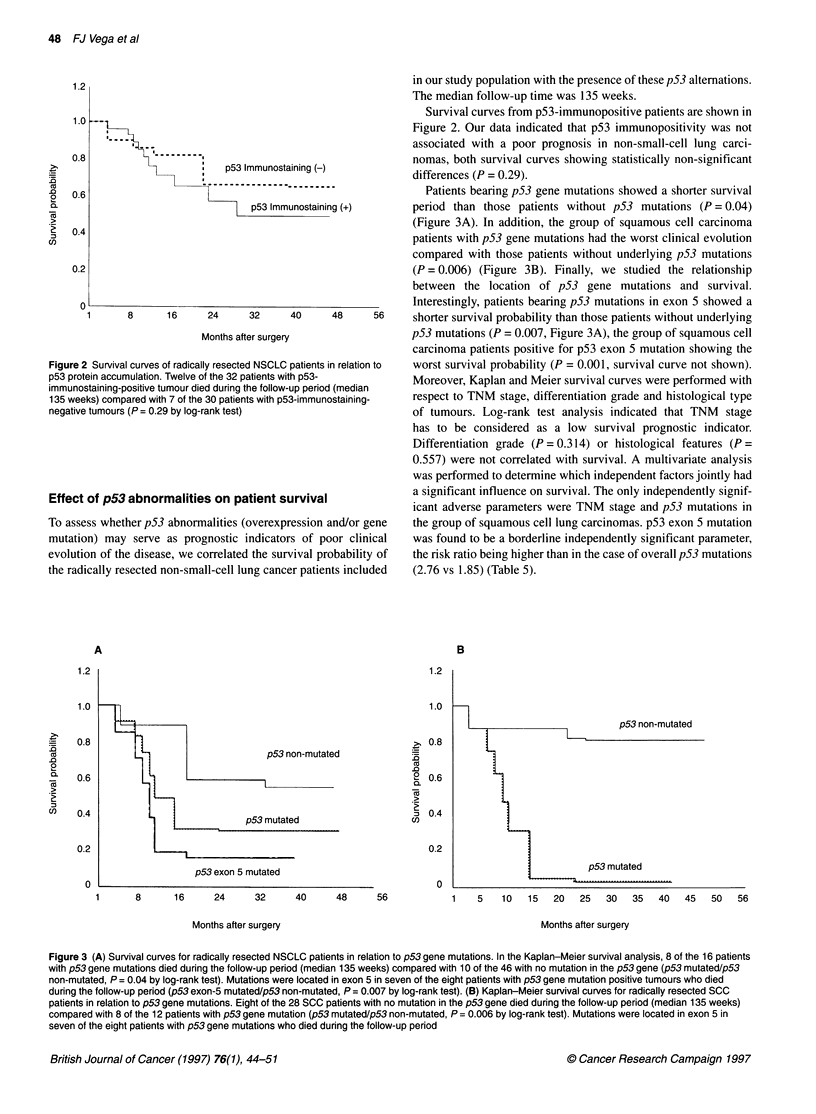
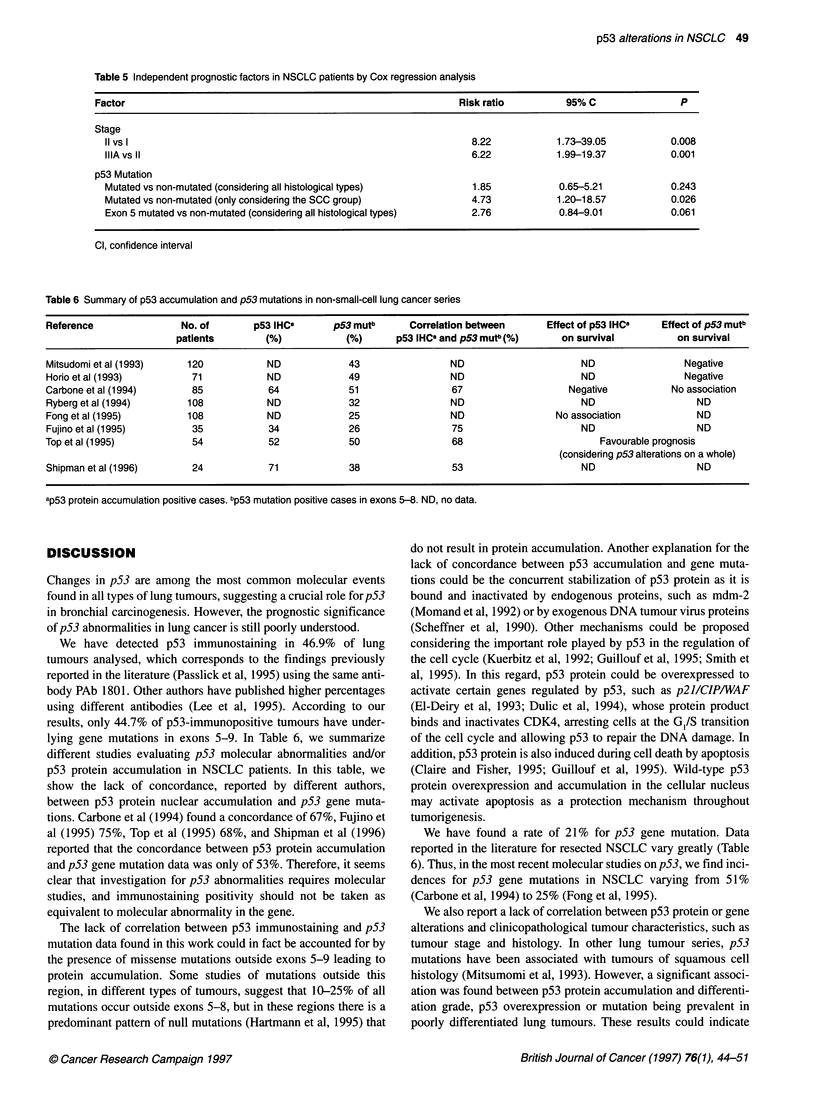
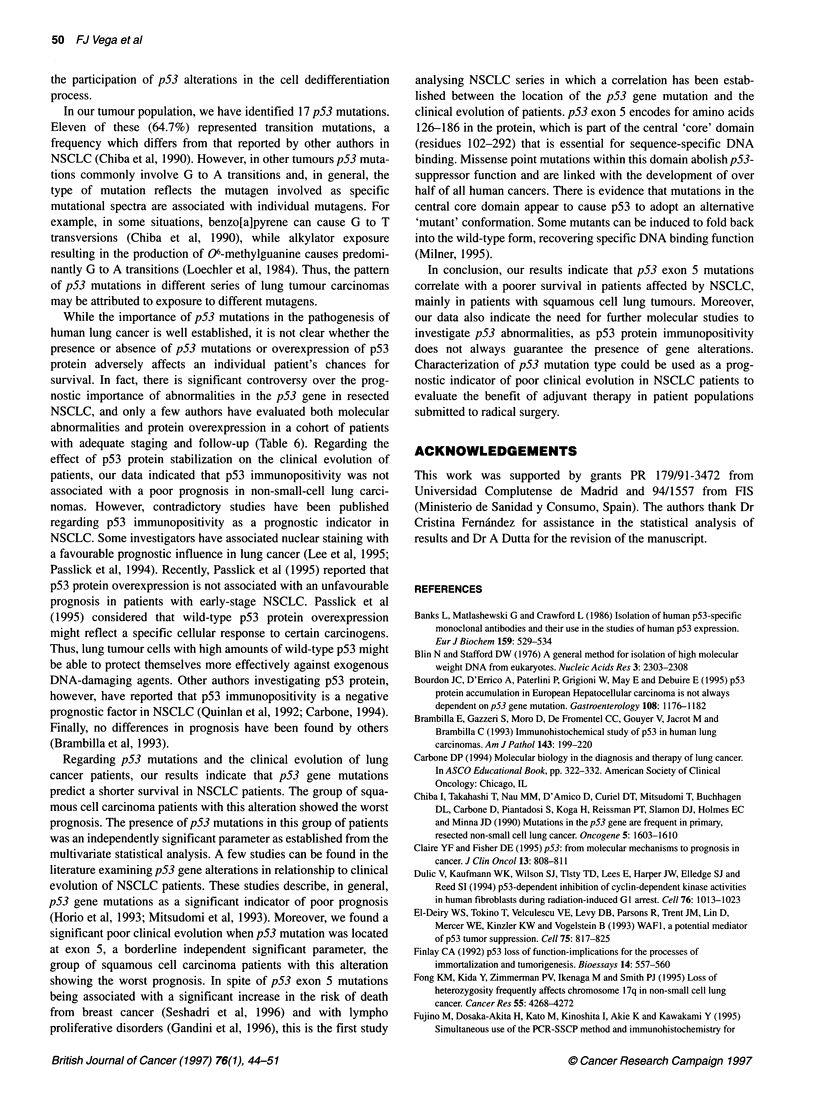
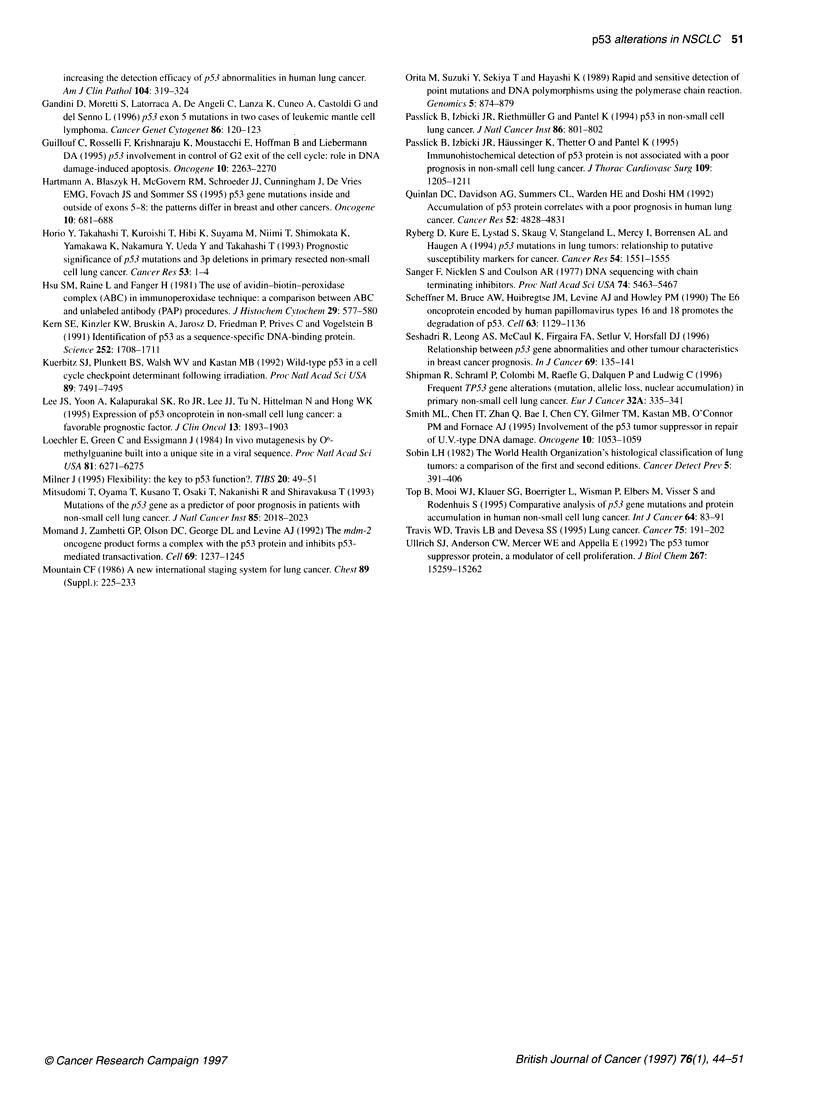
Images in this article
Selected References
These references are in PubMed. This may not be the complete list of references from this article.
- Banks L., Matlashewski G., Crawford L. Isolation of human-p53-specific monoclonal antibodies and their use in the studies of human p53 expression. Eur J Biochem. 1986 Sep 15;159(3):529–534. doi: 10.1111/j.1432-1033.1986.tb09919.x. [DOI] [PubMed] [Google Scholar]
- Blin N., Stafford D. W. A general method for isolation of high molecular weight DNA from eukaryotes. Nucleic Acids Res. 1976 Sep;3(9):2303–2308. doi: 10.1093/nar/3.9.2303. [DOI] [PMC free article] [PubMed] [Google Scholar]
- Bourdon J. C., D'Errico A., Paterlini P., Grigioni W., May E., Debuire B. p53 protein accumulation in European hepatocellular carcinoma is not always dependent on p53 gene mutation. Gastroenterology. 1995 Apr;108(4):1176–1182. doi: 10.1016/0016-5085(95)90217-1. [DOI] [PubMed] [Google Scholar]
- Brambilla E., Gazzeri S., Moro D., Caron de Fromentel C., Gouyer V., Jacrot M., Brambilla C. Immunohistochemical study of p53 in human lung carcinomas. Am J Pathol. 1993 Jul;143(1):199–210. [PMC free article] [PubMed] [Google Scholar]
- Chiba I., Takahashi T., Nau M. M., D'Amico D., Curiel D. T., Mitsudomi T., Buchhagen D. L., Carbone D., Piantadosi S., Koga H. Mutations in the p53 gene are frequent in primary, resected non-small cell lung cancer. Lung Cancer Study Group. Oncogene. 1990 Oct;5(10):1603–1610. [PubMed] [Google Scholar]
- Dulić V., Kaufmann W. K., Wilson S. J., Tlsty T. D., Lees E., Harper J. W., Elledge S. J., Reed S. I. p53-dependent inhibition of cyclin-dependent kinase activities in human fibroblasts during radiation-induced G1 arrest. Cell. 1994 Mar 25;76(6):1013–1023. doi: 10.1016/0092-8674(94)90379-4. [DOI] [PubMed] [Google Scholar]
- Finlay C. A. p53 loss of function: implications for the processes of immortalization and tumorigenesis. Bioessays. 1992 Aug;14(8):557–560. doi: 10.1002/bies.950140811. [DOI] [PubMed] [Google Scholar]
- Fong K. M., Kida Y., Zimmerman P. V., Ikenaga M., Smith P. J. Loss of heterozygosity frequently affects chromosome 17q in non-small cell lung cancer. Cancer Res. 1995 Oct 1;55(19):4268–4272. [PubMed] [Google Scholar]
- Fujino M., Dosaka-Akita H., Kato M., Kinoshita I., Akie K., Kawakami Y. Simultaneous use of the PCR-SSCP method and immunohistochemistry for increasing the detection efficacy of p53 abnormalities in human lung cancer. Am J Clin Pathol. 1995 Sep;104(3):319–324. doi: 10.1093/ajcp/104.3.319. [DOI] [PubMed] [Google Scholar]
- Fung C. Y., Fisher D. E. p53: from molecular mechanisms to prognosis in cancer. J Clin Oncol. 1995 Apr;13(4):808–811. doi: 10.1200/JCO.1995.13.4.808. [DOI] [PubMed] [Google Scholar]
- Gandini D., Moretti S., Latorraca A., De Angeli C., Lanza F., Cuneo A., Castoldi G., del Senno L. p53 exon 5 mutations in two cases of leukemic mantle cell lymphoma. Cancer Genet Cytogenet. 1996 Feb;86(2):120–123. doi: 10.1016/0165-4608(95)00173-5. [DOI] [PubMed] [Google Scholar]
- Guillouf C., Rosselli F., Krishnaraju K., Moustacchi E., Hoffman B., Liebermann D. A. p53 involvement in control of G2 exit of the cell cycle: role in DNA damage-induced apoptosis. Oncogene. 1995 Jun 1;10(11):2263–2270. [PubMed] [Google Scholar]
- Hartmann A., Blaszyk H., McGovern R. M., Schroeder J. J., Cunningham J., De Vries E. M., Kovach J. S., Sommer S. S. p53 gene mutations inside and outside of exons 5-8: the patterns differ in breast and other cancers. Oncogene. 1995 Feb 16;10(4):681–688. [PubMed] [Google Scholar]
- Horio Y., Takahashi T., Kuroishi T., Hibi K., Suyama M., Niimi T., Shimokata K., Yamakawa K., Nakamura Y., Ueda R. Prognostic significance of p53 mutations and 3p deletions in primary resected non-small cell lung cancer. Cancer Res. 1993 Jan 1;53(1):1–4. [PubMed] [Google Scholar]
- Hsu S. M., Raine L., Fanger H. Use of avidin-biotin-peroxidase complex (ABC) in immunoperoxidase techniques: a comparison between ABC and unlabeled antibody (PAP) procedures. J Histochem Cytochem. 1981 Apr;29(4):577–580. doi: 10.1177/29.4.6166661. [DOI] [PubMed] [Google Scholar]
- Kern S. E., Kinzler K. W., Bruskin A., Jarosz D., Friedman P., Prives C., Vogelstein B. Identification of p53 as a sequence-specific DNA-binding protein. Science. 1991 Jun 21;252(5013):1708–1711. doi: 10.1126/science.2047879. [DOI] [PubMed] [Google Scholar]
- Kuerbitz S. J., Plunkett B. S., Walsh W. V., Kastan M. B. Wild-type p53 is a cell cycle checkpoint determinant following irradiation. Proc Natl Acad Sci U S A. 1992 Aug 15;89(16):7491–7495. doi: 10.1073/pnas.89.16.7491. [DOI] [PMC free article] [PubMed] [Google Scholar]
- Lee J. S., Yoon A., Kalapurakal S. K., Ro J. Y., Lee J. J., Tu N., Hittelman W. N., Hong W. K. Expression of p53 oncoprotein in non-small-cell lung cancer: a favorable prognostic factor. J Clin Oncol. 1995 Aug;13(8):1893–1903. doi: 10.1200/JCO.1995.13.8.1893. [DOI] [PubMed] [Google Scholar]
- Loechler E. L., Green C. L., Essigmann J. M. In vivo mutagenesis by O6-methylguanine built into a unique site in a viral genome. Proc Natl Acad Sci U S A. 1984 Oct;81(20):6271–6275. doi: 10.1073/pnas.81.20.6271. [DOI] [PMC free article] [PubMed] [Google Scholar]
- Milner J. Flexibility: the key to p53 function? Trends Biochem Sci. 1995 Feb;20(2):49–51. doi: 10.1016/s0968-0004(00)88954-9. [DOI] [PubMed] [Google Scholar]
- Mitsudomi T., Oyama T., Kusano T., Osaki T., Nakanishi R., Shirakusa T. Mutations of the p53 gene as a predictor of poor prognosis in patients with non-small-cell lung cancer. J Natl Cancer Inst. 1993 Dec 15;85(24):2018–2023. doi: 10.1093/jnci/85.24.2018. [DOI] [PubMed] [Google Scholar]
- Momand J., Zambetti G. P., Olson D. C., George D., Levine A. J. The mdm-2 oncogene product forms a complex with the p53 protein and inhibits p53-mediated transactivation. Cell. 1992 Jun 26;69(7):1237–1245. doi: 10.1016/0092-8674(92)90644-r. [DOI] [PubMed] [Google Scholar]
- Orita M., Suzuki Y., Sekiya T., Hayashi K. Rapid and sensitive detection of point mutations and DNA polymorphisms using the polymerase chain reaction. Genomics. 1989 Nov;5(4):874–879. doi: 10.1016/0888-7543(89)90129-8. [DOI] [PubMed] [Google Scholar]
- Passlick B., Izbicki J. R., Häussinger K., Thetter O., Pantel K. Immunohistochemical detection of P53 protein is not associated with a poor prognosis in non-small-cell lung cancer. J Thorac Cardiovasc Surg. 1995 Jun;109(6):1205–1211. doi: 10.1016/S0022-5223(95)70204-0. [DOI] [PubMed] [Google Scholar]
- Passlick B., Izbicki J. R., Riethmüller G., Pantel K. p53 in non-small-cell lung cancer. J Natl Cancer Inst. 1994 May 18;86(10):801–803. doi: 10.1093/jnci/86.10.801. [DOI] [PubMed] [Google Scholar]
- Quinlan D. C., Davidson A. G., Summers C. L., Warden H. E., Doshi H. M. Accumulation of p53 protein correlates with a poor prognosis in human lung cancer. Cancer Res. 1992 Sep 1;52(17):4828–4831. [PubMed] [Google Scholar]
- Ryberg D., Kure E., Lystad S., Skaug V., Stangeland L., Mercy I., Børresen A. L., Haugen A. p53 mutations in lung tumors: relationship to putative susceptibility markers for cancer. Cancer Res. 1994 Mar 15;54(6):1551–1555. [PubMed] [Google Scholar]
- Sanger F., Nicklen S., Coulson A. R. DNA sequencing with chain-terminating inhibitors. Proc Natl Acad Sci U S A. 1977 Dec;74(12):5463–5467. doi: 10.1073/pnas.74.12.5463. [DOI] [PMC free article] [PubMed] [Google Scholar]
- Scheffner M., Werness B. A., Huibregtse J. M., Levine A. J., Howley P. M. The E6 oncoprotein encoded by human papillomavirus types 16 and 18 promotes the degradation of p53. Cell. 1990 Dec 21;63(6):1129–1136. doi: 10.1016/0092-8674(90)90409-8. [DOI] [PubMed] [Google Scholar]
- Seshadri R., Leong A. S., McCaul K., Firgaira F. A., Setlur V., Horsfall D. J. Relationship between p53 gene abnormalities and other tumour characteristics in breast-cancer prognosis. Int J Cancer. 1996 Apr 22;69(2):135–141. doi: 10.1002/(SICI)1097-0215(19960422)69:2<135::AID-IJC12>3.0.CO;2-8. [DOI] [PubMed] [Google Scholar]
- Shipman R., Schraml P., Colombi M., Raefle G., Dalquen P., Ludwig C. Frequent TP53 gene alterations (mutation, allelic loss, nuclear accumulation) in primary non-small cell lung cancer. Eur J Cancer. 1996 Feb;32A(2):335–341. doi: 10.1016/0959-8049(95)00535-8. [DOI] [PubMed] [Google Scholar]
- Smith M. L., Chen I. T., Zhan Q., O'Connor P. M., Fornace A. J., Jr Involvement of the p53 tumor suppressor in repair of u.v.-type DNA damage. Oncogene. 1995 Mar 16;10(6):1053–1059. [PubMed] [Google Scholar]
- Sobin L. H. The World Health Organization's Histological Classification of Lung Tumors: a comparison of the first and second editions. Cancer Detect Prev. 1982;5(4):391–406. [PubMed] [Google Scholar]
- Top B., Mooi W. J., Klaver S. G., Boerrigter L., Wisman P., Elbers H. R., Visser S., Rodenhuis S. Comparative analysis of p53 gene mutations and protein accumulation in human non-small-cell lung cancer. Int J Cancer. 1995 Apr 21;64(2):83–91. doi: 10.1002/ijc.2910640203. [DOI] [PubMed] [Google Scholar]
- Travis W. D., Travis L. B., Devesa S. S. Lung cancer. Cancer. 1995 Jan 1;75(1 Suppl):191–202. doi: 10.1002/1097-0142(19950101)75:1+<191::aid-cncr2820751307>3.0.co;2-y. [DOI] [PubMed] [Google Scholar]
- Ullrich S. J., Anderson C. W., Mercer W. E., Appella E. The p53 tumor suppressor protein, a modulator of cell proliferation. J Biol Chem. 1992 Aug 5;267(22):15259–15262. [PubMed] [Google Scholar]
- el-Deiry W. S., Tokino T., Velculescu V. E., Levy D. B., Parsons R., Trent J. M., Lin D., Mercer W. E., Kinzler K. W., Vogelstein B. WAF1, a potential mediator of p53 tumor suppression. Cell. 1993 Nov 19;75(4):817–825. doi: 10.1016/0092-8674(93)90500-p. [DOI] [PubMed] [Google Scholar]



